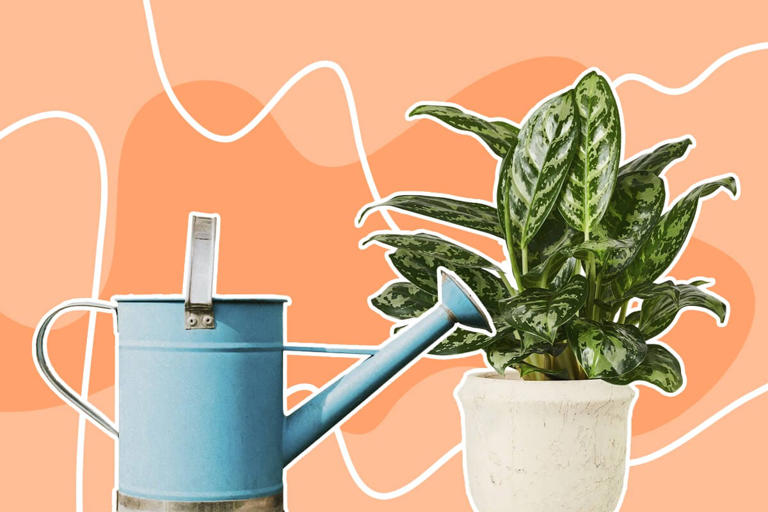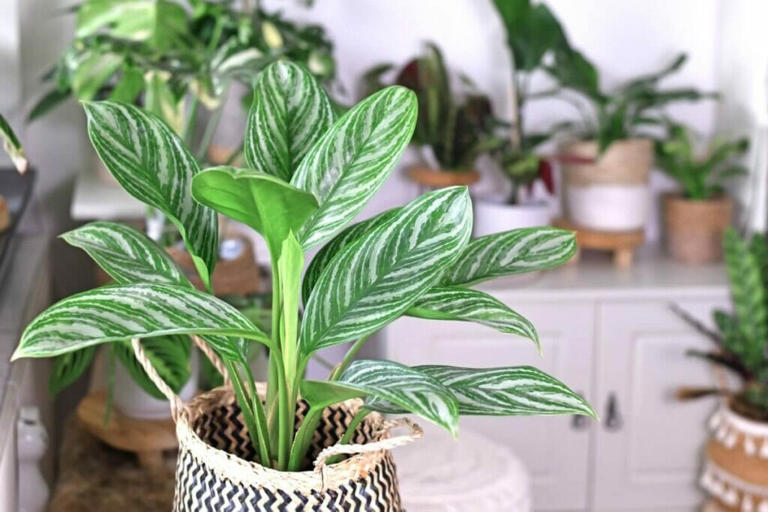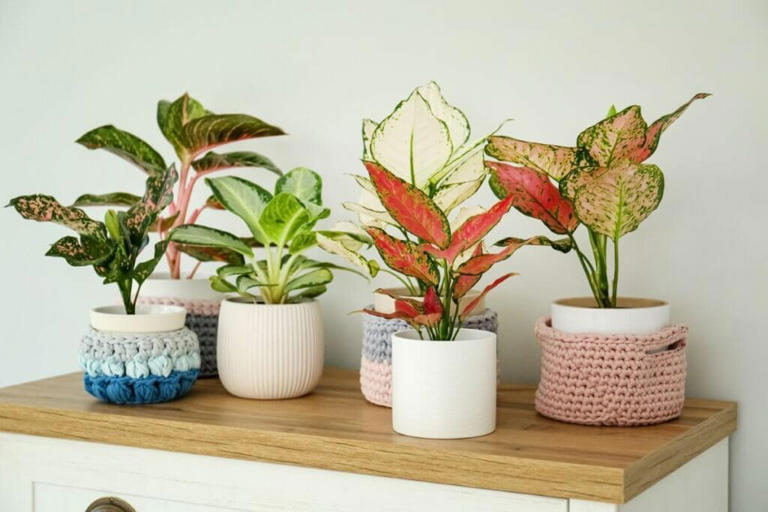How to Water Aglaonema Plants at Home
Like many other leafy houseplants, Aglaonemas (Chinese Evergreens) prefer their soil to dry out slightly, but not entirely, before the...© Provided by Petal Republic
When to Water Aglaonemas
In my experience, the best aglaonema soil base needs to be well-draining and dry out a little in-between each watering cycle. The soil should not be left to dry out completely, but it shouldn’t always remain moist either. A balance is needed to ensure the plant has consistent access to water when it needs it, without sitting in water for long
My go-to signal to water an Aglaonema is a dry top layer of soil. When the visible soil surface is dry, check the moisture levels about 3 inches down. As soon as this top section of soil dries out, I know it’s time to water again.
If you happen to forget to water your plant, it will display some visible signs that indicate it needs a drink. The most common sign I notice is wilting or dropping leaves. As the foliage on some varieties is large and quite thin, they will begin to collapse when the cells don’t have enough water to hold up the leaves.
More structural varieties are less vocal about their watering needs and may only indicate a more severe problem when the leaf edges begin to turn yellow.
How to Check When to Water
I find the best way to avoid underwatering or overwatering is to check the moisture levels regularly and only water when necessary. The simplest way to do this is by sticking your finger in the top layer of soil. If you can feel the soil is dry or if no soil sticks to your finger, the plant needs water.
If you don’t feel like getting your hands dirty, you have a few other options, like a moisture meter. Simply stick the end into the top layer of soil, and it will provide a reading of how dry the soil is. Alternatively, you can use a far less technologically advanced method – a stick. Pop the stick into the top layer of soil, and if it comes back dry, you need to water your plant.
Aglaonemas also have relatively shallow root systems. In deep pots, the best way to test soil moisture is to pick the pot up. If it feels heavy, there is still water in the soil at the bottom of the pot. If it is light, it needs to be watered.
How Often Do Aglaonemas Typically Need Watering?
The time between watering will largely depend on other environmental conditions like where the plant is positioned, sunlight exposure, ambient temperature, and the season. However, the soil will generally dry out within 1-2 weeks, needing another watering within that period.
I always check the soil before watering rather than using a schedule, as this can lead to over or underwatering.
Environmental Considerations That May Impact Watering Cycles
Chinese Evergreens prefer a healthy amount of moderate indirect light throughout the day. When placed in lower lighting conditions, the soil will dry out far slower, increasing the time between watering.
Temperatures can also influence watering cycles. In hotter weather, the soil will dry out faster, needing additional watering sooner than usual. In cooler weather, the plant can be left for three weeks or so without requiring any water.
Placement is also a factor. Aglaonemas left in front of open windows or air conditioning units will dry out incredibly quickly. It’s best to keep these plants away from drafts to prevent them from drying out and facing stress.
Seasonal Considerations That May Affect Watering Cycles
Once the weather begins to warm in spring, the plant will need consistent watering every week or so (in addition to monthly fertilizing). This is not only due to higher temperatures but also due to the energy required to produce new growth.
As temperatures increase in summer, you can continue this watering frequency or potentially increase watering depending on your indoor home temperatures. Once the weather begins to cool in fall and winter, slow your watering to a minimum of two-week intervals, with up to three or four weeks in very cold winter temperatures.
The Importance of Good Drainage
Good watering doesn’t only involve how much water you give the plant and when. It starts with good drainage (and plenty of it). Drainage, both in the pot and in the soil mix you choose, will prevent water from collecting around the roots, limiting the risk of root rot.
A lack of drainage holes in your pot will cause water to collect and stagnate underneath the roots, encouraging bacterial growth. Excessively moist soil can also attract aglaonema pests and create the ideal environment for fungal growth.
What Type of Water is Best for Aglaonemas?
As tap water can contain excessive amounts of chlorine and fluoride, filtered water is best. Rainwater is even better as it is ideal for plant growth and saves water at the same time. If tap water is the only option, leave it out at room temperature for a day or two to let the chlorine evaporate out.
Room temperature or slightly warm water is preferred. Ice-cold water, especially in winter, will shock the roots.
How to Water Aglaonemas
It’s best to water your Chinese Evergreen with a watering can or over the sink. Water only the soil, avoiding the foliage to prevent moisture build-up and disease. Continue to water until you see water leak from the drainage holes.
If the soil is excessively dry, bottom watering is the best method. In this case, follow these steps:
- Fill a sink, bath, or bucket with enough water to reach halfway up the pot.
- Place the pot in the water, resting on the bottom of the container. If the pot is too light and begins to float, weigh it down with a few rocks placed on top of the soil.
- Leave the pot submerged for 15-30 minutes, or until you see the water level stop dropping.
- Remove the pot from the water, shake off any excess soil, and return the pot to its original spot.
If your plant is placed inside a decorative cover with no drainage holes, always remove it before watering and only return the pot to the cover when all excess water has drained. This prevents the pot from sitting in stagnant water.
Similarly, the pot should not be left in a tray filled with water. About 10 minutes after watering, ensure you remove all excess water from the drip tray and return it to its original place.
Signs You Might Be Overwatering
Overwatering is a common mistake when it comes to Chinese Evergreens. Your plant will display signs of overwatering through yellowing leaves or soft, mushy stems. To rectify the problem, leave the soil to dry out before your next watering and increase times between watering.
If you overwater the plant for extended periods, the roots may experience root rot. In this case, you will need to remove all the soil from the pot, cut off all the affected roots with clean, disinfected pruning shears, and repot into the new soil.
Signs You Might Be Underwatering
Drooping or wilting leaves are the most common sign of underwatering. Some varieties can even act as watering indicators, as their thin leaves begin to droop quicker than other foliage plants. As soon as you see the Aglaonema leaves starting to fall over, water immediately.
A more damaging and long-term sign of underwatering is dry leaves and brown leaf tips. This indicates the plant has been left without water for long periods and is desperate for a drink. Water as soon as possible and check the soil more frequently to determine the right time to water.
What to Do In Between Watering Cycles
When you’re not watering, always keep an eye out for signs the plant needs water by checking the soil and examining the leaves. Changes in temperature or light levels can also impact the soil, so check every couple of days at a minimum.
You can also improve moisture around the plant by increasing humidity to the levels it prefers. Chinese Evergreens will be happiest in rooms with about 60% humidity but handle less humidity better than other tropical plants. Use a humidifier to increase the humidity around your plants.
The large leaves can also collect dust over time. In between watering cycles, use a damp cloth to wipe down the leaves. This will improve photosynthesis and gas exchange.
The Role of Water in Plant Health and Development
Water is one of the most essential building blocks of life. When it comes to plants housed indoors, it is up to plant owners to deliver that water to the plants to keep them alive.
Without water, plants lose almost all function. As their cells are made up mostly of water, they begin to lose their shape without it, resulting in the wilting leaves indicative of a watering problem. Water is also the vehicle that nutrients travel through to get to the parts of the plant that need it.
And, on top of all that, photosynthesis is impossible without water, preventing your plant from producing any energy for growth and survival.
Watering Aglaonemas FAQs:
What are the most common signs an Aglaonema needs watering?
Drooping or wilting leaves are typical indicators, with browning tips being a sign of a more serious problem. If you notice the leaves aren’t standing as upright, as usual, give your plant plenty of water.
What is the best way to water Aglaonemas?
Water the soil around the foliage with a watering can or over the sink, avoiding the foliage. If the soil is extremely dry, water from the bottom by submerging half the pot in a container or bath of water for 15-30 minutes,
How much water do Aglaonemas need?
Aglaonemas are moderate water users, needing a deep watering (until water leaves the pot’s drainage holes) every 1-2 weeks.
Is it ok to get water on Aglaonema plant leaves?
Chinese Evergreens have large, dense leaves that can trap water if watered overhead. This creates the perfect environment for diseases to develop, so it’s best to avoid the foliage and focus only on the soil.
What do I do if I overwater my Aglaonema?
If you overwater once or twice, simply increase the time before your next watering, and your plant should survive. If the problem is more severe, you may have caused root rot, which is detrimental to plant health. In this case, remove the plant from the pot and wash all the soil off the roots. Trim off the affected roots with sharp scissors and repot into new soil, cleaning and disinfecting the pot before repotting.
Can I water my Aglaonema with tap water?
Avoid using tap water to water your Aglaonema as it can lead to chlorine build-up in the soil. Opt for filtered water, or leave the water out at room temperature for at least 24 hours to allow the chlorine to evaporate.
Should I mist my Aglaonema?
Chinese Evergreens do prefer a higher humidity but will manage well in humidity as low as 40%. Misting the leaves is not necessary and may result in an increased risk of fungal diseases.
Wrap Up
If you’re looking for stand-out foliage guaranteed to turn heads, you can’t go wrong with this plant. Tolerant of a wide range of lighting, temperature, and humidity conditions, they only need consistent watering every week or two and a close eye for signs of over or underwatering to keep them healthy and happy.
For more, see our in-depth guide to the best types of aglaonema plants to grow at home.
The post How to Water Aglaonema Plants at Home appeared first on Petal Republic.
Story by Petal Republic


